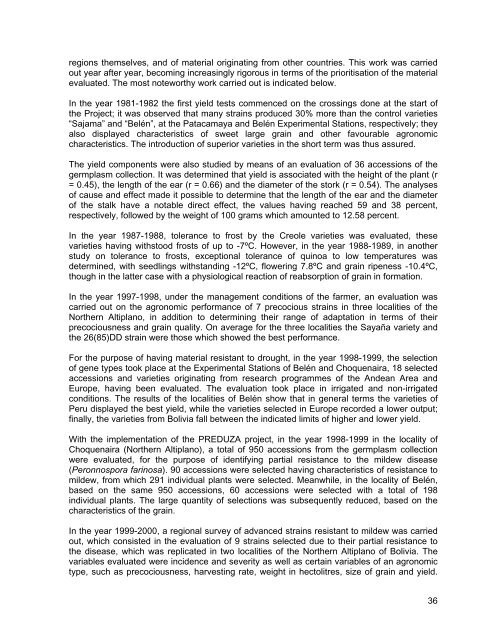Study on the social, environmental and economic impacts of quinoa ...
Study on the social, environmental and economic impacts of quinoa ...
Study on the social, environmental and economic impacts of quinoa ...
Create successful ePaper yourself
Turn your PDF publications into a flip-book with our unique Google optimized e-Paper software.
egi<strong>on</strong>s <strong>the</strong>mselves, <strong>and</strong> <strong>of</strong> material originating from o<strong>the</strong>r countries. This work was carried<br />
out year after year, becoming increasingly rigorous in terms <strong>of</strong> <strong>the</strong> prioritisati<strong>on</strong> <strong>of</strong> <strong>the</strong> material<br />
evaluated. The most noteworthy work carried out is indicated below.<br />
In <strong>the</strong> year 1981-1982 <strong>the</strong> first yield tests commenced <strong>on</strong> <strong>the</strong> crossings d<strong>on</strong>e at <strong>the</strong> start <strong>of</strong><br />
<strong>the</strong> Project; it was observed that many strains produced 30% more than <strong>the</strong> c<strong>on</strong>trol varieties<br />
“Sajama” <strong>and</strong> “Belén”, at <strong>the</strong> Patacamaya <strong>and</strong> Belén Experimental Stati<strong>on</strong>s, respectively; <strong>the</strong>y<br />
also displayed characteristics <strong>of</strong> sweet large grain <strong>and</strong> o<strong>the</strong>r favourable agr<strong>on</strong>omic<br />
characteristics. The introducti<strong>on</strong> <strong>of</strong> superior varieties in <strong>the</strong> short term was thus assured.<br />
The yield comp<strong>on</strong>ents were also studied by means <strong>of</strong> an evaluati<strong>on</strong> <strong>of</strong> 36 accessi<strong>on</strong>s <strong>of</strong> <strong>the</strong><br />
germplasm collecti<strong>on</strong>. It was determined that yield is associated with <strong>the</strong> height <strong>of</strong> <strong>the</strong> plant (r<br />
= 0.45), <strong>the</strong> length <strong>of</strong> <strong>the</strong> ear (r = 0.66) <strong>and</strong> <strong>the</strong> diameter <strong>of</strong> <strong>the</strong> stork (r = 0.54). The analyses<br />
<strong>of</strong> cause <strong>and</strong> effect made it possible to determine that <strong>the</strong> length <strong>of</strong> <strong>the</strong> ear <strong>and</strong> <strong>the</strong> diameter<br />
<strong>of</strong> <strong>the</strong> stalk have a notable direct effect, <strong>the</strong> values having reached 59 <strong>and</strong> 38 percent,<br />
respectively, followed by <strong>the</strong> weight <strong>of</strong> 100 grams which amounted to 12.58 percent.<br />
In <strong>the</strong> year 1987-1988, tolerance to frost by <strong>the</strong> Creole varieties was evaluated, <strong>the</strong>se<br />
varieties having withstood frosts <strong>of</strong> up to -7ºC. However, in <strong>the</strong> year 1988-1989, in ano<strong>the</strong>r<br />
study <strong>on</strong> tolerance to frosts, excepti<strong>on</strong>al tolerance <strong>of</strong> <strong>quinoa</strong> to low temperatures was<br />
determined, with seedlings withst<strong>and</strong>ing -12ºC, flowering 7.8ºC <strong>and</strong> grain ripeness -10.4ºC,<br />
though in <strong>the</strong> latter case with a physiological reacti<strong>on</strong> <strong>of</strong> reabsorpti<strong>on</strong> <strong>of</strong> grain in formati<strong>on</strong>.<br />
In <strong>the</strong> year 1997-1998, under <strong>the</strong> management c<strong>on</strong>diti<strong>on</strong>s <strong>of</strong> <strong>the</strong> farmer, an evaluati<strong>on</strong> was<br />
carried out <strong>on</strong> <strong>the</strong> agr<strong>on</strong>omic performance <strong>of</strong> 7 precocious strains in three localities <strong>of</strong> <strong>the</strong><br />
Nor<strong>the</strong>rn Altiplano, in additi<strong>on</strong> to determining <strong>the</strong>ir range <strong>of</strong> adaptati<strong>on</strong> in terms <strong>of</strong> <strong>the</strong>ir<br />
precociousness <strong>and</strong> grain quality. On average for <strong>the</strong> three localities <strong>the</strong> Sayaña variety <strong>and</strong><br />
<strong>the</strong> 26(85)DD strain were those which showed <strong>the</strong> best performance.<br />
For <strong>the</strong> purpose <strong>of</strong> having material resistant to drought, in <strong>the</strong> year 1998-1999, <strong>the</strong> selecti<strong>on</strong><br />
<strong>of</strong> gene types took place at <strong>the</strong> Experimental Stati<strong>on</strong>s <strong>of</strong> Belén <strong>and</strong> Choquenaira, 18 selected<br />
accessi<strong>on</strong>s <strong>and</strong> varieties originating from research programmes <strong>of</strong> <strong>the</strong> Andean Area <strong>and</strong><br />
Europe, having been evaluated. The evaluati<strong>on</strong> took place in irrigated <strong>and</strong> n<strong>on</strong>-irrigated<br />
c<strong>on</strong>diti<strong>on</strong>s. The results <strong>of</strong> <strong>the</strong> localities <strong>of</strong> Belén show that in general terms <strong>the</strong> varieties <strong>of</strong><br />
Peru displayed <strong>the</strong> best yield, while <strong>the</strong> varieties selected in Europe recorded a lower output;<br />
finally, <strong>the</strong> varieties from Bolivia fall between <strong>the</strong> indicated limits <strong>of</strong> higher <strong>and</strong> lower yield.<br />
With <strong>the</strong> implementati<strong>on</strong> <strong>of</strong> <strong>the</strong> PREDUZA project, in <strong>the</strong> year 1998-1999 in <strong>the</strong> locality <strong>of</strong><br />
Choquenaira (Nor<strong>the</strong>rn Altiplano), a total <strong>of</strong> 950 accessi<strong>on</strong>s from <strong>the</strong> germplasm collecti<strong>on</strong><br />
were evaluated, for <strong>the</strong> purpose <strong>of</strong> identifying partial resistance to <strong>the</strong> mildew disease<br />
(Per<strong>on</strong>nospora farinosa). 90 accessi<strong>on</strong>s were selected having characteristics <strong>of</strong> resistance to<br />
mildew, from which 291 individual plants were selected. Meanwhile, in <strong>the</strong> locality <strong>of</strong> Belén,<br />
based <strong>on</strong> <strong>the</strong> same 950 accessi<strong>on</strong>s, 60 accessi<strong>on</strong>s were selected with a total <strong>of</strong> 198<br />
individual plants. The large quantity <strong>of</strong> selecti<strong>on</strong>s was subsequently reduced, based <strong>on</strong> <strong>the</strong><br />
characteristics <strong>of</strong> <strong>the</strong> grain.<br />
In <strong>the</strong> year 1999-2000, a regi<strong>on</strong>al survey <strong>of</strong> advanced strains resistant to mildew was carried<br />
out, which c<strong>on</strong>sisted in <strong>the</strong> evaluati<strong>on</strong> <strong>of</strong> 9 strains selected due to <strong>the</strong>ir partial resistance to<br />
<strong>the</strong> disease, which was replicated in two localities <strong>of</strong> <strong>the</strong> Nor<strong>the</strong>rn Altiplano <strong>of</strong> Bolivia. The<br />
variables evaluated were incidence <strong>and</strong> severity as well as certain variables <strong>of</strong> an agr<strong>on</strong>omic<br />
type, such as precociousness, harvesting rate, weight in hectolitres, size <strong>of</strong> grain <strong>and</strong> yield.<br />
36

















